Light and Dark – Cambodia
Monday, June 18th, 2007Thus far in my travels, no place has marked me quite like Cambodia. The very moment after crossing over the border from Thailand, I feel that it’s different from anywhere I’ve been. Even before making it out of Thailand, a young man dressed in black follows us around the border control, trying to be “helpful,” asking us where we’re from, where we plan to go. He loses us as we walk through customs and finds us again on the other side.
Trying to shake him, we ignore him as he continues to talk to us. We stumble through the mud streets, swaying under our heavy packs, stepping over piles of garbage and mangy dogs. This is a border town in a poor country. Kids with protruding bellies run around barefoot, in fact most people aren’t wearing shoes. Peddle carts and motorbikes are everywhere, making for noise and commotion, fumes in the air. People approach us from all directions in dirty torn clothes, asking us where we’re going. They’re persistent. They get right in our faces. “Where you go? Where you go? Hey lady!” Somehow we make it to the bus station but the last bus to Siem Reap is gone. Finally we jump in a taxi for a whopping 20 bucks each for 3 hours along an all-dirt road. It’s a bumpy ride. It’s dark outside and lightning reveals the horizon like a flash bulb. I ask myself what I’m getting into.
In Seam Reap, things relax a bit. It’s a tourist town, after all, with paved streets and less trash. There’s plenty of Barang (foreigners) to go around so the tuk-tuks call to us from a distance. I feel my shoulders drop and my jaw de-clench.
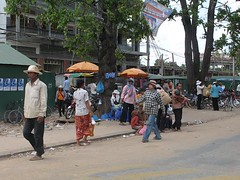
Here, the tourists are a bigger mix of Asians with Westerners. There are many Chinese, Koreans and Cambodians as well. We Occidents are few in the crowd. There are no McDonalds, no 7-11’s (quite popular in Thailand), nothing that screams “home” for me, and I like that. There are plenty of pretty things to buy, though, and we make our way through the dark, hot markets, our eyes widening at the silks and statues, the opium pipes and the artwork.
The first thing on our to-do list, besides nabbing a few scarves, is Angkor Wat. It’s a collection of stone temples from the 12th century, sometimes Buddhist and Hindu in the same temple, spanning over a few square kilometers. We start the day at sunrise, when the air is cool on our clammy skin.
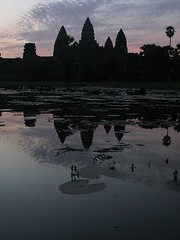
Stepping into the magnific structure feels like walking through Indiana Jones or Tomb Raider (which it should, because the latter was filmed there).
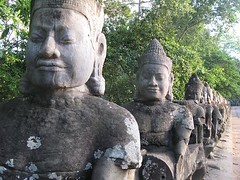
Thick roots and vines hang down over huge stone blocks, some in ruin, others still quite intact. Sculptures dance, fight and meditate in the shadows on the walls while real monkeys scramble over the rooftops.
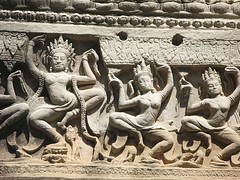
From some places you can hear monks humming in meditation and shrines to Buddha pop up in every other corner, the smoke from their incense adding to the mystic feel of it all.
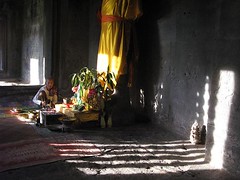
Though we’re in awe of the immensity of it, by noon we’re burnt out and hot.
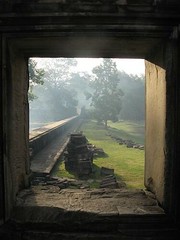
The next day we’re off to Cambodia’s capitol, Phnom Penh. From the bus window, rice patties float by, broken up with clusters of palm trees and houses on stilts. It’s in Phnom Penh that we see the dark sinister side of Cambodia’s story, over 5 years of civil war, forced labor, and genocide under Pol Pot and his Khmer Rouge Regime, which took over the capitol and then the country in 1975. When we arrive, I’ve already started reading about the atrocities committed not 30 years ago in a book called “First They Killed My Father.” It makes me cry. It’s strange to me to read a personal story about a girl as she witnesses her family members’ deaths and endures work in a forced labor camp while I’m traveling through the country where it happened. Anyone in their 40’s on the bus with me went through the same thing and yet they look so normal to me. They’re going about their daily lives, smiling at their babies, chatting and eating snacks. 30 years ago the majority of them were literally starving.
We settle in to our Guesthouse and set out to see two things that will actually widen my view of the world in an important way. One is the Killing Fields, a place where people were executed regularly and thrown into mass graves. The other is Tuol Sleng, a high school turned prison, where the communist Khmer Rouge Regime tortured people for many reasons, including being involved in the former government, being a doctor, being educated, wearing glasses, speaking another language, being related to one of these people or for no reason but being in the wrong place at the wrong time.
Walking through The Killing Fields, if you didn’t know where you were, you might think it a pleasant place to be. Soft breezes bend flowers and leaves in the sun while big butterflies flit by. There are grand, leafy trees surrounding a grassy park where a tall stupa stands in the middle, its golden rooftop gleaming. But a closer look evokes a chill as it reveals the thousands of skulls piled on shelves inside, a tribute to those who were murdered here.
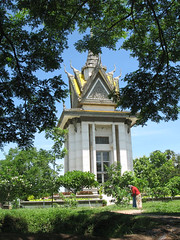
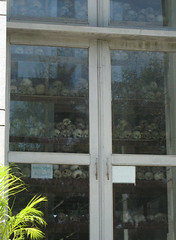
Look even closer and you can even see pieces of clothing still sticking up out of the dirt in places and shards of bone in others. A guide tells a group of people how the Khmer Rouge killed babies and again, I cry. I walk around slowly, trying to take it in, and spot two little boys just outside, hanging on to the chain link fence. They smile at me and say “hello!” I say “hello.” Then in unison, they sing “Picture? One, two, three, smile! One, two, three, smile!” When I tell them no picture, they ask for some money. I give them crayons instead, which they take with glee and skip back off into the fields next door.
Tuol Sleng, the prison, is gruesome. Though it still looks like a high school on the outside, rusty iron beds and torture instruments remain in their original rooms, sometimes with a blown-up black and white photo of the people found maimed and dead in them on the wall. Thousands of mug shots fill a room, black and white photos of the faces of people, all ages, who know they will die. After Vietnam chased the Khmer Rouge away, many people were missing family members. Some of them learned of their death by seeing their picture here in the museum.
The Lonely Planet calls Cambodia a “land of contrasts.” This annoys me. It seems the Lonely Planet is always calling places this. But this time I can’t help feeling that it is a place that deserves to be branded as such. Before going there, the word “Cambodia” didn’t evoke much for me. Now, I think of gigantic stone faces smiling serenely at me from temples in the jungle, delicious curries, and friendly people. Sounds nice, and it is, but once you know of it, it’s impossible to ignore the recent past full of genocide, war, torture, and terror that goes along with the impressive ancient culture. Everyone over 30 in the country saw death and ruin on their own soil. They lived in constant fear and hunger under a regime that outlawed such things as cars, jewelry, watches, personal possessions, love, music, or anything that might encourage individuality and spirit. People walk in the streets of Phnom Penh with missing arms and legs from stepping on land mines as children. The economy is still struggling to make up for the loss. But in time, they’ve rebuilt their homes, their families, their lives. They haven’t forgotten, yet they go on.
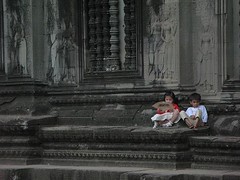
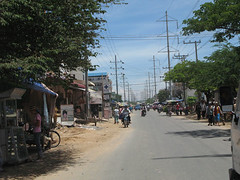
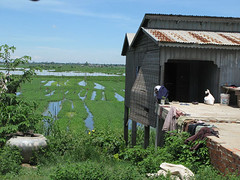
If you’re interested and can stand the gruesome details, I suggest reading the two books I’ve read while here:
First They Killed My Father, by Loung Ung, and
When Broken Glass Floats, by Chanrithy Him (who now lives in Eugene, OR)
Both are first-hand accounts by women of life (and struggling to keep it) as a young girl during the Khmer Rouge Regime.
Wikipedia has all sorts of info on Cambodia
There is also the movie “The Killing Fields”
And then there’s the Campaign for A Landmine Free World
